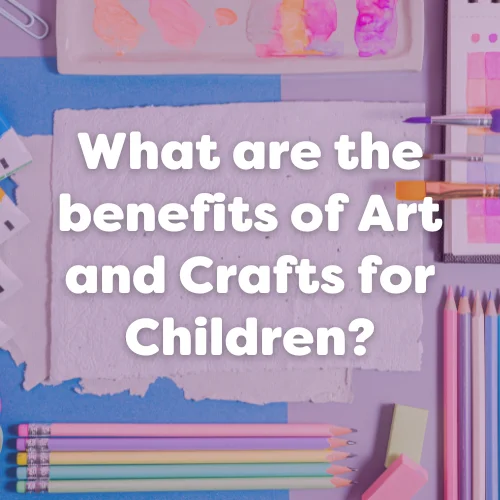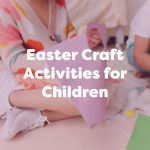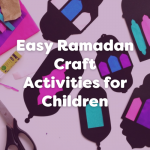Art & Crafts have tremendous developmental benefits for young children. They are, of course, great for incorporating the Expressive Arts & Design element of the EYFS, but are also vital in allowing children to have fun and to express themselves in a ‘risk free’ environment. This encourages communication, collaboration and teamwork along with many other benefits. In this blog we will cover some of these many benefits and offer some activities you may want to try with your little ones!

1. Problem solving & critical thinking
Exploring and experimenting with art and craft encourages children to use independent thought. Thus equipping them with critical thinking skills that are important for later success in both school and life.
Consider giving your children a collection of random objects – this could be from around your setting or outdoors, think leaves, sponge, cardboard etc – and task them with creating an art piece. Children will be required to think outside the box and plan their masterpiece, prompting them to think critically and solve the challenge presented to them.
2. Fine motor skills
Art activities typically require children to use the small muscles in their hands, helping them to develop dexterity and fine motor skills. These skills are a huge benefit as they contribute towards later tasks such as writing, eating and generally taking care of themselves.
Experiment with different tools and mediums in your art explorations. Finger painting, building shapes with clay and weaving are all examples of art activities but provide children with different opportunities to develop their fine motor skills.
3. Improves self-esteem & self-expression
Often, art projects provide children with a way in which to express themselves to build upon their self-esteem and feelings of self-worth. Additionally, completing a project can often have the effect of an increased sense of pride and achievement, also contributing to overall self-esteem and confidence.
Why not try this: when your little ones are drawing or getting creative, encourage them to explain their decisions to you for example “why is that character you’ve drawn smiling?” This will offer children an opportunity to discuss their deeper feelings with you.
4. Understanding the world
Art and crafts can be used as an effective tool with which to introduce new topics in your setting such as cultures, diversity, seasons, or even new materials. This provides children with lots of opportunities to build a better picture of the world around them.
Why not take your children outside at various times of the year to gather natural materials and create art masterpieces. This will offer them a chance to compare the seasons and the natural resources available to better understand our world.
5. Improved mental health
Arts and crafts can improve children’s mental health in a number of different ways. Firstly, art activities can work as a distraction from stress helping children to process their feelings of stress in a constructive way. Secondly art projects can be used to build confidence which in turn supports mental health. As children “make art” they will discover it is okay to make mistakes and try new ideas.
Why not try mindful art? Encourage children to make different marks on paper that represent their breathing. This allows children to focus on their breath to bring them into a calm state all whilst engaging in art and crafts.
6. Literacy & mathematics
Art can be used to compliment different curricular topics like maths and literacy. Through art, children are able to identify colours, shapes and patterns which are some of the foundations for early maths. Similarly, art can provide the foundation for early literacy skills. Using paints and crayons, children can practice marks and shapes that form pre-writing patterns – a series of lines and patterns that make up commonly used letters.
Activity suggestion: on your tuff tray write out the alphabet in large letters. Add your acrylic tuff tray mat on top so that children can see the letters through the mat. Then encourage them to copy the letters through any medium they choose. This could be tracing using paint, adding pebbles along the lines or simply finger painting. Familiarity will increase and muscle memory will kick in for later literacy and writing.
7. Creativity and Imagination
It goes without saying that art and crafts can be used to enhance creativity and imagination however the importance of this should not be overlooked. Introducing arts and crafts at an early age can help to foster a love of creativity to last a lifetime and support children in coming up with new creative ideas and solutions in all areas of later life.
To support creativity and imagination – try and offer a range of resources and be as open ended as possible. Children do not need to be constrained to a paintbrush and paints, a twig and leaves could be turned into a paintbrush and be used to create unique imaginative masterpieces!
8. Social skills & Teamwork
Large scale art projects are a great way for children to work together, find common ground and learn to communicate. It can also be used as a great icebreaker in a new setting for children to make friends.
Why not, at the start of a new term, create a display for your setting with your children. This will encourage teamwork, communication and encourage children to get talking with their peers to make friends.
We would love to see how you utilize art and crafts in your setting. Share your experiences with us on social media by tagging us or using the hashtag #ExploreWithEYR.
For more art and craft activity ideas then check out more of our art and craft blogs here.



